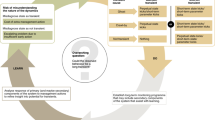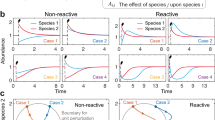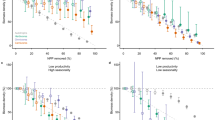Abstract
Shifting ecosystem disturbance patterns due to climate change (for example, storms, droughts and wildfires) or direct human interference (for example, harvests and nutrient loading) highlight the importance of quantifying and strengthening the resilience of desired ecological regimes. Although existing metrics capture resilience to isolated shocks, gradual parameter changes, and continual noise, quantifying resilience to repeated, discrete disturbance events requires different analytical tools. Here, we introduce a mathematical flow–kick framework that uses dynamical systems tools to quantify resilience to disturbances explicitly in terms of their magnitude and frequency. We identify a boundary between disturbance regimes that cause either escape from, or stabilization within, a basin of attraction. We use the boundary to define resilience metrics tailored to repeated, discrete perturbations. The flow–kick model suggests that the distance-to-threshold resilience metric overestimates resilience in the context of repeated perturbations. It also reveals counterintuitive triggers for regime shifts. These include increasing the periods between disturbance events in proportion to increases to disturbance magnitude, and—in systems with multiple dynamic variables—increasing time periods between disturbances of constant magnitude.
This is a preview of subscription content, access via your institution
Access options
Access Nature and 54 other Nature Portfolio journals
Get Nature+, our best-value online-access subscription
$29.99 / 30 days
cancel any time
Subscribe to this journal
Receive 12 digital issues and online access to articles
$119.00 per year
only $9.92 per issue
Buy this article
- Purchase on Springer Link
- Instant access to full article PDF
Prices may be subject to local taxes which are calculated during checkout





Similar content being viewed by others
Data availability
The MATLAB scripts and functions used in the study are available from the open-source GitHub repository at https://github.com/katejmeyer/NatSust2018.
References
IPCC Climate Change 2014: Synthesis Report (eds Core Writing Team, Pachauri, R. K. & Meyer, L. A.) (IPCC, 2014).
Dale, V. H. et al. Climate change and forest disturbances. BioScience 51, 723–734 (2001).
Russell-Smith, J. & Thornton, R. Perspectives on prescribed burning. Front. Ecol. Environ. 11, e3 (2013).
Reid, W. V. et al. Ecosystems and Human Well-being: Synthesis. A Report of the Millennium Ecosystem Assessment (Island Press, 2005).
Kareiva, P., Tallis, H., Rickets, T. H., Daily, G. C. & Polasky, S. Natural Capital: Theory and Practice of Mapping Ecosystem Services (Oxford Univ. Press, Oxford, 2011).
Walker, B. & Salt, D. Resilience Thinking: Sustaining Ecosystems and People in a Changing World (Island Press, Washington DC, 2006).
Carpenter, S. R., Walker, B., Anderies, J. M. & Abel, N. From metaphor to measurement: resilience of what to what? Ecosystems 4, 765–781 (2001).
Meyer, K. A mathematical review of resilience in ecology. Nat. Resour. Model. 29, 339–352 (2016).
Levin, S. A. & Lubchenco, J. Resilience, robustness, and marine ecosystem-based management. BioScience 58, 27–32 (2008).
Walker, B., Holling, C. S., Carpenter, S. R. & Kinzig, A. Resilience, adaptability and transformability in social–ecological systems. Ecol. Soc. 9, 5 (2004).
Menck, P. J., Heitzig, J., Marwan, N. & Kurths, J. How basin stability complements the linear-stability paradigm. Nat. Phys. 9, 89–92 (2013).
Beisner, B. E., Dent, C. L. & Carpenter, S. R. Variability of lakes on the landscape: roles of phosphorus, food webs, and dissolved organic carbon. Ecology 84, 1563–1575 (2003).
Pimm, S. L. The complexity and stability of ecosystems. Nature 307, 321–326 (1984).
Ingrish, J. & Bahn, M. Towards a comparable quantification of resilience. Trends Ecol. Evol. 33, 251–259 (2018).
Paine, R. T., Tegner, M. J. & Johnson, E. A. Compounded perturbations yield ecological surprises. Ecosystems 1, 535–545 (1998).
Dennis, B., Assas, L., Elaydi, S., Kwessi, E. & Livadiotis, G. Allee effects and resilience in stochastic populations. Theor. Ecol. 9, 323–335 (2015).
Ives, A. R. & Carpenter, S. R. Stability and diversity of ecosystems. Science 317, 58–62 (2007).
Turner, M. Disturbance and landscape dynamics in a changing world. Ecology 91, 2833–2849 (2010).
Sousa, W. P. The role of disturbance in natural communities. Annu. Rev. Ecol. Syst. 15, 353–391 (1984).
White, P. S. & Pickett, S. T. A. in The Ecology of Natural Disturbance and Patch Dynamics Ch. 1 (Academic Press, New York, 1985).
Resilience Alliance Assessing Resilience in Social-Ecological Systems: Workbook for Practitioners Revised Version 2.0 (2010); https://www.resalliance.org/files/ResilienceAssessmentV2_2.pdf
Hobbs, R. J. & Huenneke, L. F. Disturbance, diversity, and invasion: implications for conservation. Conserv. Biol. 6, 324–337 (1992).
Miller, A. D., Roxburgh, S. H. & Shea, K. How frequency and intensity shape diversity–disturbance relationships. Proc. Natl Acad. Sci. USA 108, 5643–5648 (2011).
Mack, M. C. & D’Antonio, C. M. Impacts of biological invasions on disturbance regimes. Trends Ecol. Evol. 13, 195–198 (1998).
Noble, I. R. & Slatyer, R. O. The use of vital attributes to predict successional changes in plant communities subject to recurrent disturbances. Vegetatio 43, 5–21 (1980).
Turner, M. G., Romme, W. H., Gardner, R. H., O’Neill, R. V. & Kratz, T. K. A revised concept of landscape equilibrium: disturbance and stability on scaled landscapes. Landsc. Ecol. 8, 213–227 (1993).
Fraterrigo, J. M. & Rusak, J. A. Disturbance-driven changes in the variability of ecological patterns and processes. Ecol. Lett. 11, 756–770 (2008).
Ratajczak, Z., Nippert, J. B., Briggs, J. M. & Blair, J. M. Fire dynamics distinguish grasslands, shrublands and woodlands as alternative attractors in the Central Great Plains of North America. J. Ecol. 102, 1374–1385 (2014).
Ippolito, S., Naudot, V. & Noonburg, E. G. Alternative stable states, coral reefs, and smooth dynamics with a kick. Bull. Math. Biol. 78, 413–435 (2016).
Ackman, O., Comar, T. D. & Hrozencik, D. On impulsive integrated pest management models with stochastic effects. Front. Neurosci. 9, 119 (2015).
Folke, C. et al. Regime shifts, resilience, and biodiversity in ecosystem management. Annu. Rev. Ecol. Evol. Syst. 35, 557–581 (2004).
Daniel, C., Frid, L., Sleeter, B. M. & Fortin, M. J. State-and-transition simulation models: a framework for forecasting landscape change. Methods Ecol. Evol. 7, 1413–1423 (2016).
Seidl, R., Rammer, W., Scheller, R. M. & Spies, T. A. An individual-based process model to simulate landscape-scale forest ecosystem dynamics. Ecol. Model. 231, 87–100 (2012).
Hirsch, M. W., Smale, S. & Devaney, R. L. Differential Equations, Dynamical Systems, and an Introduction to Chaos (Elsevier, Oxford, 2013).
Tchuinté Tamen, A., Dumont, Y., Tewa, J. J., Bowong, S. & Couteron, P. A minimalistic model of tree–grass interactions using impulsive differential equations and non-linear feedback functions of grass biomass onto fire-induced tree mortality. Math. Comput. Simul. 133, 265–297 (2017).
Lakshmikantham, V., Bainov, D. D. & Simeonov, P. S. Theory of Impulsive Differential Equations (World Scientific Publishing, Singapore, 1989).
Courchamp, F., Clutton-Brock, T. & Grenfell, B. Inverse density dependence and the Allee effect. Trends Ecol. Evol. 4, 405–410 (1999).
Gascoigne, J. & Lipcius, R. N. Allee effects in marine systems. Mar. Ecol. Prog. Ser. 269, 49–59 (2004).
Keith, D. M. & Hutchings, J. A. Population dynamics of marine fishes at low abundance. Can. J. Fish. Aquat. Sci. 69, 1150–1163 (2012).
Scheffer, M., Carpenter, S., Foley, J. A., Folke, C. & Walker, B. Catastrophic shifts in ecosystems. Nature 413, 591–596 (2001).
Carpenter, S. R., Ludwig, D. & Brock, W. A. Management of eutrophication for lakes subject to potentially irreversible change. Ecol. Appl. 9, 751–771 (1999).
Wang, R. et al. Flickering gives early warning signals of a critical transition to a eutrophic lake state. Nature 492, 419–422 (2012).
Stommel, H. Thermohaline convection with two stable regimes of flow. Tellus 13, 224–230 (1961).
Thornalley, D. J. R. et al. Anomalously weak Labrador Sea convection and Atlantic overturning during the past 150 years. Nature 556, 227–230 (2018).
Jackson, L. C. et al. Global and European climate impacts of a slowdown of the AMOC in a high resolution GCM. Clim. Dynam. 45, 3299–3316 (2015).
Fairbanks, R. G. A 17,000-year glacio-eustatic sea level record: influence of glacial melting rates on the Younger Dryas event and deep-ocean circulation. Nature 342, 637–642 (1989).
Cessi, P. A simple box model of stochastically forced thermohaline flow. J. Phys. Oceanogr. 24, 1911–1920 (1994).
Van Nes, E. H. & Scheffer, M. Slow recovery from perturbations as a generic indicator of a nearby catastrophic shift. Am. Nat. 169, 738–747 (2007).
May, R. M. Thresholds and breakpoints in ecosystems with a multiplicity of stable states. Nature 269, 471–477 (1977).
Zeeman, M. L. et al. Resilience of socially valued properties of natural systems to repeated disturbance: a framework to support value-laden management decisions. Nat. Resour. Model. 31, e12170 (2018).
Acknowledgements
This work was supported by an NSF Graduate Research Fellowship (grant number 00039202 to K.M.), the Mathematics and Climate Change Research Network (NFS grant DMS-0940243) and the Computational Sustainability Network (NSF grant CCS-1521672). Thanks go to A. Shaw, L. Sullivan, J. Cowles, K. Kimmel, E. Strombom, F. Isbell and A. Rossberg for feedback on various stages of the manuscript. We are also indebted to the Ecology Theory Group at the University of Minnesota, and A. Helfgott, S. Lord, D. McGehee and C. Chong for helpful conversations.
Author information
Authors and Affiliations
Contributions
M.L.Z. and S.I. conceived of the flow–kick model of disturbance. All authors contributed to development of the model and analysis of the resulting dynamics. K.M. wrote the manuscript, and S.I., A.H.-L., I.K., V.L., E.B. and M.L.Z. contributed to the revisions.
Corresponding author
Ethics declarations
Competing interests
The authors declare no competing interests.
Additional information
Publisher’s note: Springer Nature remains neutral with regard to jurisdictional claims in published maps and institutional affiliations.
Supplementary information
Supplementary Information
Supplementary Tables 1–2, Supplementary Methods, Supplementary Figures 1–3, Supplementary Discussion, Supplementary References
Rights and permissions
About this article
Cite this article
Meyer, K., Hoyer-Leitzel, A., Iams, S. et al. Quantifying resilience to recurrent ecosystem disturbances using flow–kick dynamics. Nat Sustain 1, 671–678 (2018). https://doi.org/10.1038/s41893-018-0168-z
Received:
Accepted:
Published:
Issue Date:
DOI: https://doi.org/10.1038/s41893-018-0168-z
This article is cited by
-
Toward a Multi-stressor Theory for Coral Reefs in a Changing World
Ecosystems (2024)
-
Invasiveness of a Growth-Migration System in a Two-dimensional Percolation cluster: A Stochastic Mathematical Approach
Bulletin of Mathematical Biology (2022)
-
Management implications of long transients in ecological systems
Nature Ecology & Evolution (2021)
-
Impulsive Fire Disturbance in a Savanna Model: Tree–Grass Coexistence States, Multiple Stable System States, and Resilience
Bulletin of Mathematical Biology (2021)
-
Reduced ecological resilience jeopardizes zero loss of biodiversity using the mitigation hierarchy
Nature Ecology & Evolution (2020)



